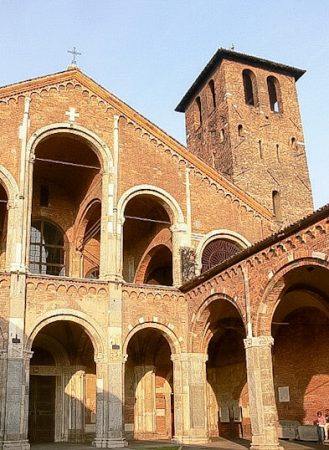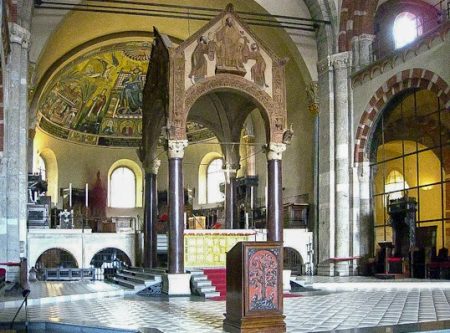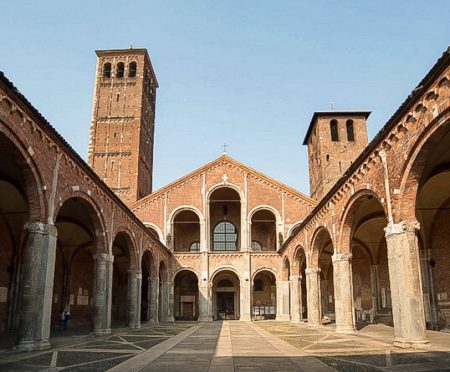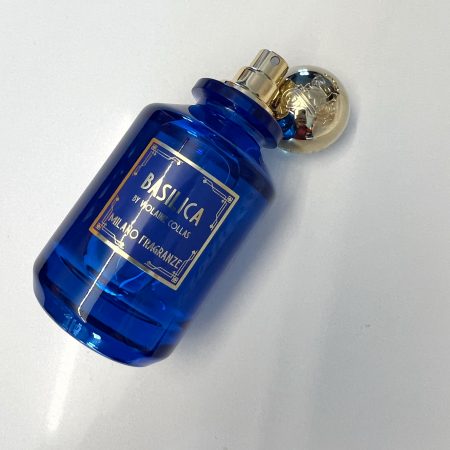
Milan’s Basilica di Sant’Ambrogio for Milano Fragranze Basilica photo courtesy of Ermano Picco
“Let my prayer be directed as incense in Thy sight, the lifting up of my hands as an evening sacrifice,” sings King David (Psalm 140: 2).
Imagine, if you will – the dim, candlelit stone walls of Milan’s Basilica di Sant’Ambrogio reverberating with the unaccompanied antiphonal chanting of soloist and choir – vocalizing melodies which originated during St. Ambrose’s tenure as bishop of Milan during the 4th century. His remains continue to lie in state in an embossed silver urn, clothed in white vestments in the crypt of the basilica. The entire edifice is filled with an odor of sanctity: this is the fragrance of Milano Fragranze Basilica. King David’s psalm is echoed in a portion of the prayer offered up by a priest as he incenses the altar. Long before the Temple of Solomon, before the Christian Era, incense was known and utilized in ceremonial worship – from the Babylonians and Egyptians to the Greeks (who until well after Homer, knew primarily of citrus and cedar smoke alone). Around the 8th C. BCE, frankincense was thought to have made it way to Hellenic shores via the Phoenicians, courtesy of Cyprus’ cult of Aphrodite, where it had been utilized.

Milan’s Basilica di Sant’Ambrogio
The Romans burned incense ritually, and it was not until the 7th C. BCE that those precious tears found their way into biblical text: “Take unto thee spices, stacte, and onycha, galbanum of sweet savour, and the clearest frankincense, all shall be of equal weight. And thou shalt make incense compounded by the work of the perfumer, well-tempered together, and pure, and most worthy of sanctification. And when thou hast beaten all into a very small powder, thou shalt set of it before the tabernacle of the testimony, in the place where I will appear to thee” (Ex. 30:34-36). In addition to this Old Testament receipt there is mention of the use of myrrh, cassia, spikenard, saffron, costus, canella, cinnamon, soap of Carsina, and “a herb fitted to raise a fume,” during Mosaic times. Such was the holiness of sacred resin that it pervaded religious literature and transcended geographical boundaries.
In the Roman Catholic rites during Mass the priest intones before the Introit (a psalm or antiphonal hymn sung or said before the Eucharist): “Mayest thou be blessed by Him in Whose honor thou art to be burnt. Amen.” Once more is the incense blessed, before the offering of the chalice (which holds sacramental wine aka the blood of Christ). Perhaps it is fitting that the tears of a wounded tree are twice blessed in the Mass. The symbolism is undeniable, powerful as any potentate.

Milan’s Basilica di Sant’Ambrogio by Ermano Picco©
Enter Milano Fragranze Basilica, a perfume in which every aromatic material has its own sacred space. Nothing in it is superfluous, capricious – from the employment of thyme and rosemary (medicinal, purifying and quite possibly the herbs suggested to Moses in Temple times) to its soft milk accord. Why milk? I’m positing that it is associated not only with comfort and healing – but hearkening back to olibanum, or frankincense (the same etymological origin as gum benjamin/benzoin), its name derived from the Hebrew word lebhonah, milk – which then became the Arabic word luban, meaning incense. I don’t really believe in coincidences. Labdanum recalls the citrusy, conifer/amber warmth the Ancient Greeks cherished, as does the fine Virginia cedarwood which is present. Other sanctified woods lend their voices: Santamanol TM (Mane), which evokes sandalwood, and cypriol aka nagarmotha – a woody note which reminds one of oudy aspects. On so many levels, Basilica calls into play the beauty of ritual and those woods employed for devotional purpose. When one considers all these facets, Milano Fragranze Basilica surpasses its original intent of recreating a quintessentially Milanese experience and becomes a fragrance with a more universal message. Those who are fond of incense fragrances are certain to enjoy it.
Notes: thyme, rosemary, warm milk accord, labdanum hyperessence, incense resinoid, cypriol, Virginia cedarwood, Santamanol TM
Samples provided by Milan Fragranze – mille grazie! My nose is my own.
Ida Meister, Deputy and Natural Perfumery Editor

photo courtesy of Milano Fragranze©
Thanks to the generosity of Milano Fragranze we have a 100ml bottle of Milano Fragranze Basilica for one registered reader in the US, EU or UK. You must register or your entry will not count. To be eligible, please leave a comment saying what you enjoyed the most about Ida’s review, have you tried any of Milano Fragranze fragrances and where you live. Draw closes 10/18/21
Please see ÇaFleureBon Video Editor Steven from Redolessence interview with Creative Director Alessandro Brun here and Sr Editor Nicoleta Tomsa’s review of Milano Fragranze La Prima here
Available on Milano Fragranze’s site.
Also available at Perfumology.com
Follow us on Instagram @cafleurebon@idameister @milanofragranze @brunalessandro @violaine_collas_parfumeur
This is our Privacy and Draw Rules Policy
Like our Facebook page Çafleurebon and use our blog feed for new updates and articles
We announce the winners only on our site and on our Facebook page, so like Çafleurebon and use our blog feed… or your dream prize will be just spilled perfume.
